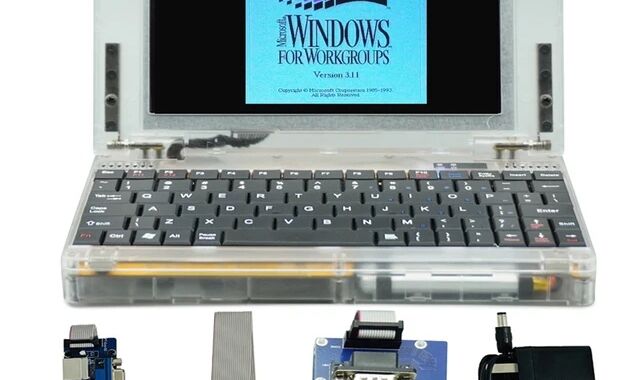- cross-posted to:
- [email protected]
- [email protected]
- cross-posted to:
- [email protected]
- [email protected]
Pocket 386 supports external accessories and will just barely run Windows 95.
This is cool but not for $200. That’s way overpriced for something this underpowered.
Right? Surely you could translate it to run on a $1 esp32?
This is actual hardware. Yes simple arm cores can pretty faithfully emulate much of this. But that’s emulation. These are bespoke devices, built from actual old chips. Offering a level of comparability and predictability emulation can’t always achieve. It isn’t for everyone.
Adrian Black ended up with a non functioning unit sent to him by a viewer that bought one. The seller rather than pay for postage for the broken one to be sent back to China just told them to keep it and sent them a replacement instead. Adrian ends up troubleshooting and fixing it but you can get a pretty good look at everything going on inside and some of the old chips involved.
The M6117C also isn’t the original and not that old. Also the 8MB of RAM aren’t true to the original.
I’m not sure. I occasionally use emulation. And I think it’s fine. Unless you’re a speed runner and need everything to be exact to the frame timing, you won’t notice. Certainly not for a desktop UI like the Win 3.11 on the photo. I guess it depends on the use-case.
Something like a FPGA or an ESP32 can also be repaired, replaced, programmed and most of the things a CPU or different architecture can do. And if the emulation layer doesn’t have too many flaws, it’ll be pretty realistic. Not exactly the same thing, but I think it’ll do for practically any use-case. And it comes with other benefits.
I think you’re allowed to do it just for the sake of it. But I often see people using an original SNES because “emulation is shit” and then they proceed to connect it to the TV set in their livingroom, which isn’t even close to the original experience because it adds lots of latency and doesn’t have interlacing and the colors are different than on a CRT, too. I think that’s just having strong opinions despite being uneducated. And I think I’m equally as well off with my Raspberry Pi and Emulationstation. (Which can also run DOS games.)
In the end everyone is entitled to their opinion. But this also isn’t the original (You can get an old Laptop… I have one with an 486.) But this isn’t the original but a replica. And it’s debatable (in my opinion) whether it’s the CPU architecture that does the realism, or other factors. I think for realism, you’d need a black and white liquid crystal display, a NiMH battery that degrades fast if you don’t charge it right and half the amount of RAM at most. And maybe just a floppy drive. The CPU is something you wouldn’t notice with the current state of technology.
It is actual compatible hardware though. And the opl chips etc are no longer made.
For myself emulation and FPGA are fine. But for speed running or any other number of things, actual hardware are important.
Agreed. I think most prominently competitive gaming; development where you need to assure it later on actually works as intended on the target platform; and business stuff where parties are obliged by contract to guarantee something works flawlessly and keeps running that way - are good examples.
That laptop doesn’t look to me like it was intended to do any of that, so that’s maybe why I’m being a bit negative here. It’s cool and a nice idea, though…
(And we already have ARM-based retro machines, FPGA clones if popular processors available. So there is no need for them to do the exact same thing.)
Companies are actually willing to pay a lot of money for legacy hardware.
Maybe, but this doesn’t seem to be a product made for businesses. It looks like a product designed for hobbyists.
Running anything on a 386 was NOT fun. I don’t think I’d pay $200 for the privilege of hating it all over again.
At the same time, it forced me to learn. Nowadays, every game and app you’d want is a few clicks away, and most likely it’ll just work without having to think about IRQ settings or COM ports or whether there’s enough space on your 50 MB hard disk.
Yeah, but they should have gone with a 486DX, or SX at least. HUGE difference. The 386 was just too damned frustrating, but it was the first work PC I ever laid hands on. For a personal computer, I upgraded from a 286 to a Pentium 200.
Yeah, 486 DX4/100 was the peak of DOS gaming.
The first two ads I see under the article are for hearing aids, which probably describes the target market for this thing.
WHAT?
Found Stone Cold Steve Austin.
Out of curiosity, what’s the utility in this? Is it meant to be a toy of sorts?
I’ve got a 486SX industrial PC that I refurbed. Much fun!
But you can hardly expand this thing at all. And there’s a hella dividing line between a 386 and any given 486. I got mine loaded with 128MB, USB floppy emulator (a MUST have) and an SSD (through adapters). You just can’t do that with this animal, can’t even add a math coprocessor.
I’d give $20 to have one to play with, that’s it.
Nostalgia
Possibly for government use? I know of a few systems running on the oldest software possible.
Industrial applications might be a thing!
Probably jumping on the popularity of retro gaming
Which is about to get a whole lot harder with sony/nintendo shutting down rom sites and abandonware sites. It means you’ll need to have the original media the games came on.
And hopefully you can find that copy of Warcraft 2, Tides of Darkness on a cd thats not TOO scratched up.
“This way! No THAT WAY!!!”
Archive.org still exists and still has DMCA immunity*, you can get no-intro, goodset & redump sets on there. There is a gap in PC game ISOs currently though afaik, but steam and gog do seem to be good for covering most releases
Failing legal options, those sets will be available forever via BitTorrent
*If you’re in the US, please make sure your representative knows how important it is this continues—well, unless they’re a republican, in which case, probably better they stay oblivious if they don’t already know.
King’s Quest V
“Your scientists were so preoccupied with whether or not they could, they didn’t stop to think if they should.”
I feel like I should be hacking a Gibson from grand central station with this.
Couldn’t this be done with an FPGA?
Yeah. There’s the ao486 core available on MiSTer.
There’s also the PCem (as well as forks 86Box and PCBox) software emulators which are excellent ways of emulating old PCs.
But emulation (regardless of whether hardware or software) is not the same experience as real hardware, especially when it comes to PCs. There is the tinkering with hardware, the process of building the PC, the satisfying click of the power button and turbo button, using floppy disks, trying to get it online, etc.
Probably. Even including the RAM on chip and the rest of the mainboard, too. Take a modern flash chip, and you can emulate a vintage sized HDD with it.
What is their intended market? I see no real use for such a box. Heck, even Linux will probably come to a crawl on that box. And you can probably build something ARM based for the same price with eight gigabytes of RAM and running circles around the 386.
Retrocomputing hobbyists and collectors.







